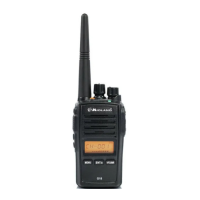14
NOTE: This radio is certified to meet standards AS/NZ 4365: 2011 and
AS/NZ 4295: 2004
Troubleshooting
Problem Possible Cause
Solution
The radio doesn’t
switch on
The battery pack is discharged and/
or has not been installed correctly.
The radio switches off
shortly after it has been
switched on
Discharged battery pack.
Verify that the battery pack is charged and
that it has been correctly installed.
Recharge the battery pack.
The battery pack does
not recharge
The battery-charger has not been
connected or installed correctly.
Inspect the connections of the battery-
charger and the installation of the batteries.
The radio switches on
but is unable to receive
signals
The site of installation is too shielded. Move to an another area.
The volume is too low. Adjust the volume level.
Incorrect CTCSS or DCS.
Check that the CTCSS tone or DCS code
corresponds to the one set by the parties
you are communicating with.
It is not possible to
communicate with
other parties
An incorrect radio channel has
been selected.
Select the same radio channel used by the
parties you are communicating with.
The radio is installed in a shielded
area or is too far from the party you
are communicating with.
Move to another area.
Incorrect CTCSS or DCS.
Check that the CTCSS tone or DCS code
corresponds to the one set by the parties
you are communicating with.
Reception is
fragmented and/or
disturbed
The signal is very weak. Try temporarily to disable the Squelch by
means of the Monitor feature.
The transmission distance is
excessive and/or there are
obstacles in the transmission path.
Move closer to the party you are
communicating with or to another area.
Other parties are using the
same channel.
Check the traffic on th radio channel by
means of the Monitor feature and select
another channel if required.
The radio has been installed
too close to equipment that
causes interference (tv's,
computers, etc.)
Increase the distance between the radio
and this equipment.
The autonomy of the
battery pack is limited
Transmission time is too
long.
Try to reduce the transmission time
and/or use a low power.

